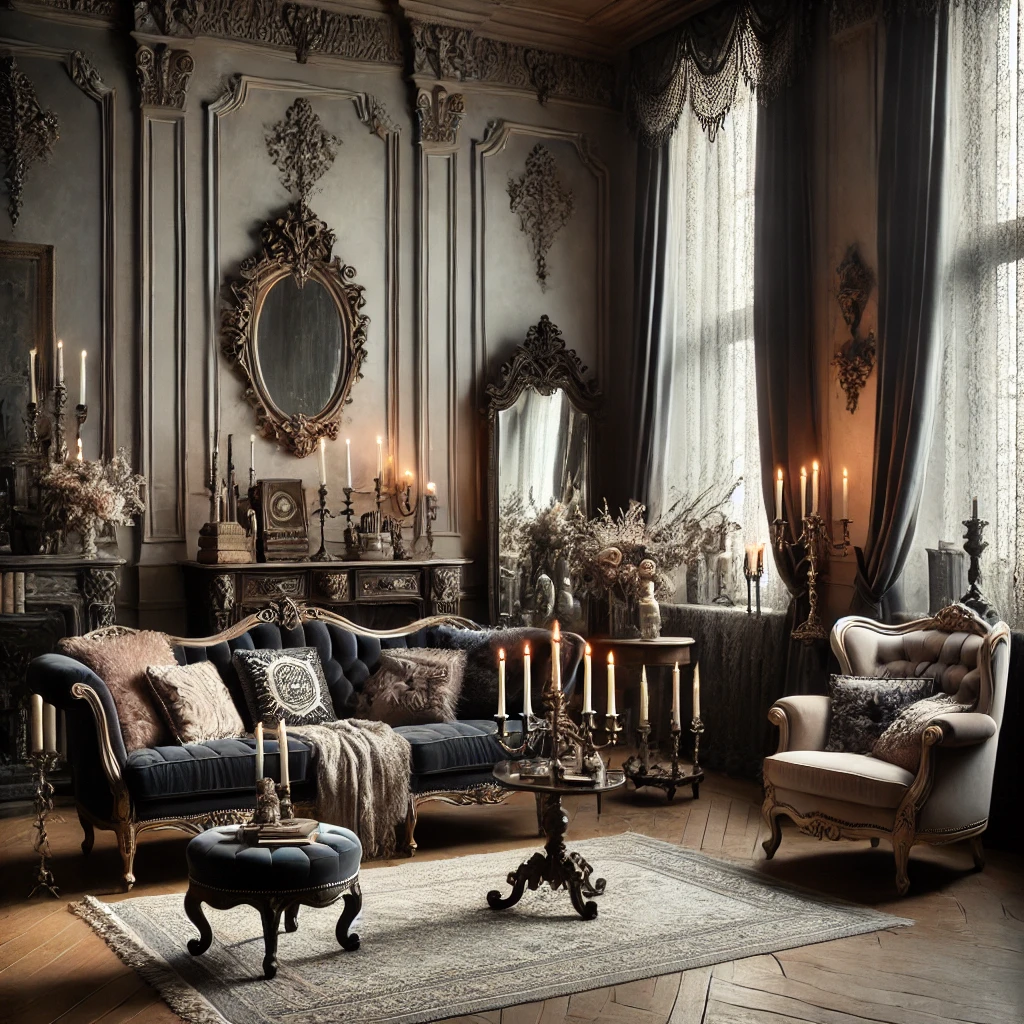I still remember the day my traditional-loving mother walked into my first apartment and gasped.
The black walls, the skull decorations, and the heavy velvet drapes had transformed my living room into a gothic sanctuary that made her question where she had gone wrong in raising me.
But that space wasn’t just decoration—it was the first time I felt truly at home, surrounded by design elements that spoke to my appreciation for the mysterious, the dramatic, and the beautifully macabre.
What many don’t understand about gothic interior design is that it’s not just about being “dark” or “scary”—it’s about creating spaces with depth, history, and emotional resonance.
These thirteen design ideas will help you create a room that honors your love of the shadows while maintaining undeniable style.
✨Click to Get My 101 FREE Designer Room Ideas
1. Victorian Gothic Grandeur: When Time Stands Still

The Victorian era gave birth to some of the most hauntingly beautiful gothic aesthetics, and bringing this style into your living room creates an instant atmosphere of elegant decay and timeless sophistication.
Think ornate carved furniture with dark wood finishes and plush velvet upholstery in deep jewel tones like burgundy, emerald, or midnight blue.
Incorporate antique (or antique-looking) pieces with intricate details—the more ornamental, the better.
Crown molding, wainscoting, and ceiling medallions instantly add period authenticity to your gothic sanctuary.
Hunt for Victorian-inspired wallpaper featuring damask patterns or floral motifs in dark colorways to create a perfect backdrop.
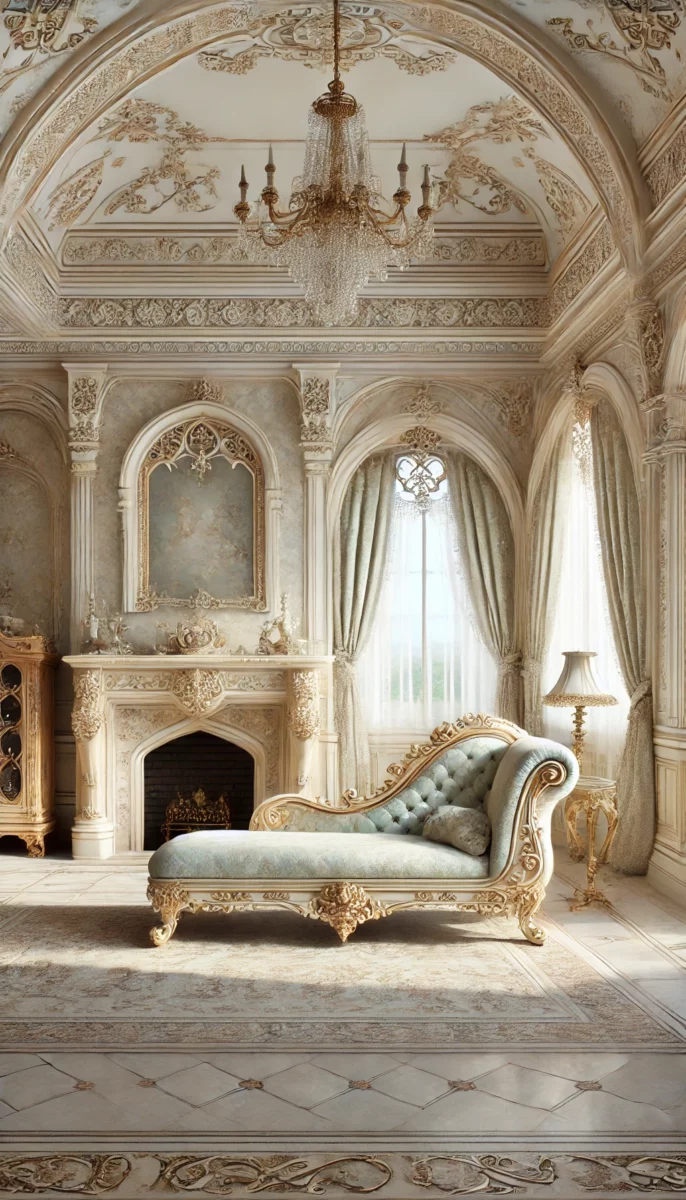
Accessorize with vintage-style frames containing botanical prints, anatomical drawings, or moody landscapes to complete the look.
Crystal decanters, ornate candelabras, and heavy drapery with tassels and fringe will transport your space to another century.
Consider a chaise lounge as a dramatic focal point—nothing says Victorian gothic quite like a fainting couch for those overwhelming moments of existential dread.
The beauty of Victorian gothic is in its details, so don’t be afraid to layer textures and decorative elements that tell a story of faded grandeur.
Remember that authentic Victorian gothic spaces weren’t actually all black—they featured rich, saturated colors against dark backgrounds for contrast and depth.
2. Modern Gothic Minimalism: Darkness Distilled
If the cluttered Victorian approach feels too heavy, modern gothic minimalism offers a contemporary twist on dark aesthetics that focuses on clean lines, negative space, and carefully selected statement pieces.
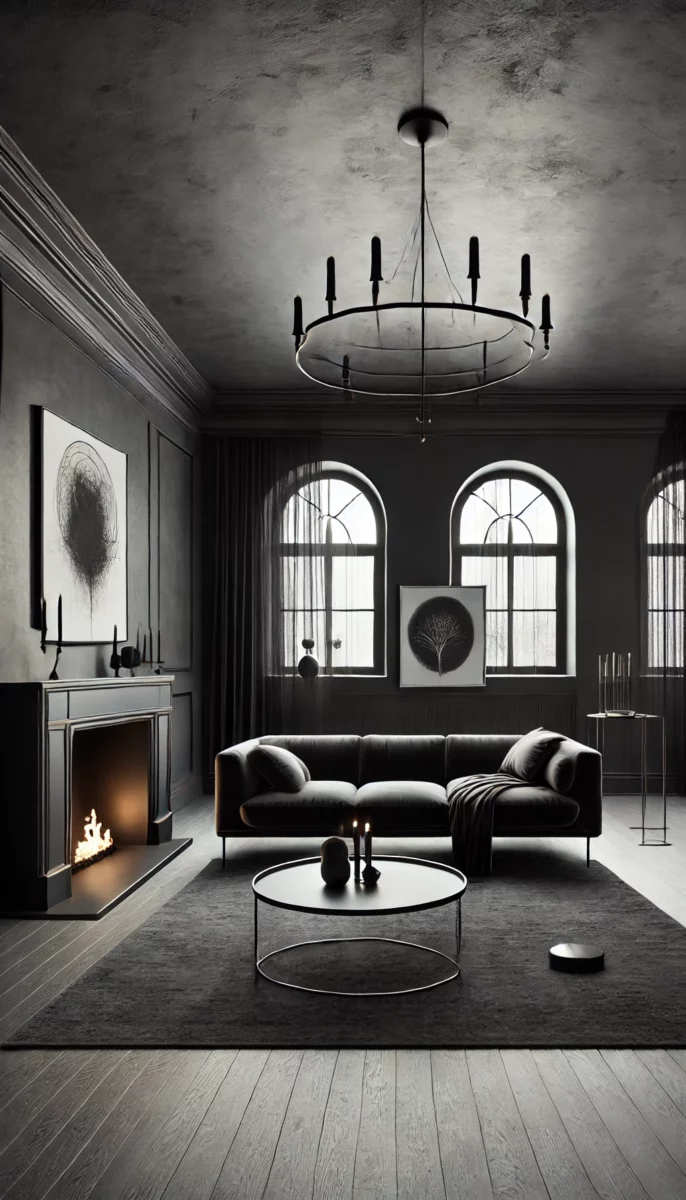
This approach maintains the gothic mood through a restrained color palette of blacks, dark grays, and perhaps a single accent color like deep red or purple.
The furniture should feature sleek, angular silhouettes rather than ornate carvings—think platform sofas with straight edges and geometric coffee tables in dark finishes.
Walls painted in matte black create the perfect backdrop for showcasing carefully curated art pieces with gothic themes.
Lighting becomes crucial in this style—incorporate sculptural light fixtures that cast dramatic shadows or wall sconces that provide indirect, moody illumination.
Instead of filling the space with many small gothic trinkets, choose fewer but larger statement pieces—perhaps a striking skull sculpture or an oversized abstract painting with dark themes.

Textiles should maintain the minimalist approach—avoid busy patterns in favor of luxurious textures like leather, suede, or silk in solid dark colors.
The floor can be concrete, polished black tile, or dark hardwood with a simple area rug featuring subtle geometric patterns.
Window treatments should be streamlined—think simple black roller blinds or sheer black curtains that diffuse light rather than heavy, ornate drapery.
Technology can be incorporated seamlessly into this aesthetic with black electronics and hidden wiring to maintain the clean lines and uncluttered feel.
3. Gothic Botanical: Where Darkness Blooms
For those who find beauty in decay and growth alike, the gothic botanical theme brings together the macabre and the natural world in perfect harmony.

Base your color scheme around deep forest greens, blacks, purples, and hints of oxidized copper or brass to create the feeling of a mysterious night garden.
Fill your space with plants that have gothic appeal—black mondas, purple heart plants, black dahlias, and dramatic ferns that create organic silhouettes against dark walls.
Look for botanical print wallpapers featuring dark florals, twisting vines, or specimens that seem pulled from a Victorian naturalist’s notebook.
Incorporate glass terrariums containing unusual plants, moss gardens, or even ethically sourced insect specimens as conversation-starting display pieces.
Dried flowers, preserved branches, and botanically-themed artwork add to the atmosphere of natural beauty touched by the hand of darkness.
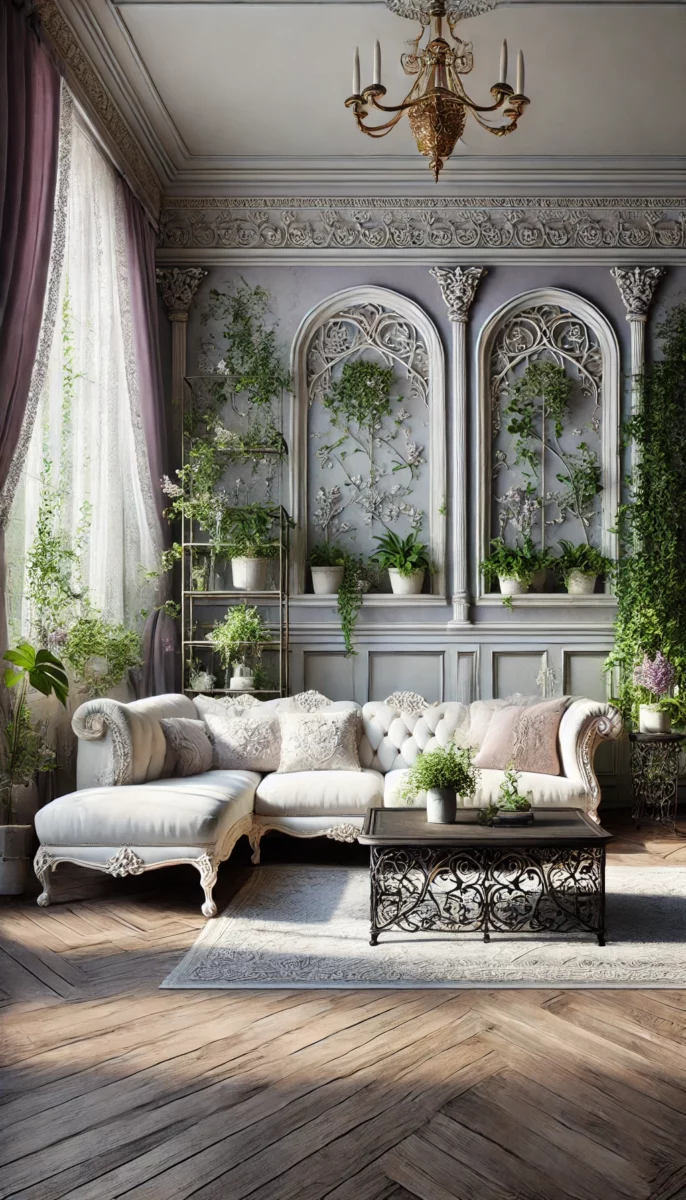
Furniture should blend the organic and the structured—consider pieces with root-like legs, leaf motifs, or wood that shows its natural grain and imperfections.
Lighting can mimic moonlight through branches with fixtures that cast patterned shadows resembling foliage.
Textiles featuring botanical prints in dark colorways add visual interest without lightening the overall gothic mood.
Don’t forget the power of scent in creating atmosphere—incense, essential oil diffusers with earthy fragrances, or botanical candles can complete the sensory experience.
4. Romantic Gothic: The Beautiful Tragedy
This style draws inspiration from gothic literature, where love and darkness intertwine in passionate, sometimes tragic narratives that speak to the beauty found in melancholy.

Deep reds, blacks, and purples dominate this color scheme, creating a space that feels both intimate and intensely emotional.
Furniture should be soft and inviting—think tufted velvet sofas, plush oversized chairs, and beds with dramatic canopies that create a sense of enclosure.
Incorporate romantic motifs like roses (real, dried, or depicted in art), hearts (anatomically correct ones, of course), and symbols of eternal love like intertwined serpents or paired ravens.
Lighting should be soft and intimate—crystal chandeliers with dimmer switches, candelabras, and scattered tea lights create the perfect ambiance for gothic romance.
Mirrors play an important role, preferably antique or with ornate frames, placed to reflect candlelight and create the illusion of expanded space.

Textiles should be sensual and tactile—velvet throws, silk pillows, and satin details invite touch and create a luxurious, seductive environment.
Wall decorations might include romantic poetry excerpts in elegant frames, vintage love letters, or artwork depicting famous gothic literary couples.
Consider a writer’s desk with an antique pen set as a nod to the gothic literary tradition that informs this aesthetic.
Music becomes an important element in this space—consider a vintage record player or discreetly placed speakers to fill your room with the sounds of darkwave, ethereal goth, or classical pieces that enhance the romantic atmosphere.
✨Click to Get My 101 FREE Designer Room Ideas
5. Industrial Gothic: The Beautiful Decay
Combining the raw edge of industrial style with gothic darkness creates spaces that feel both contemporary and timeless, celebrating the beauty in decay and abandoned structures.
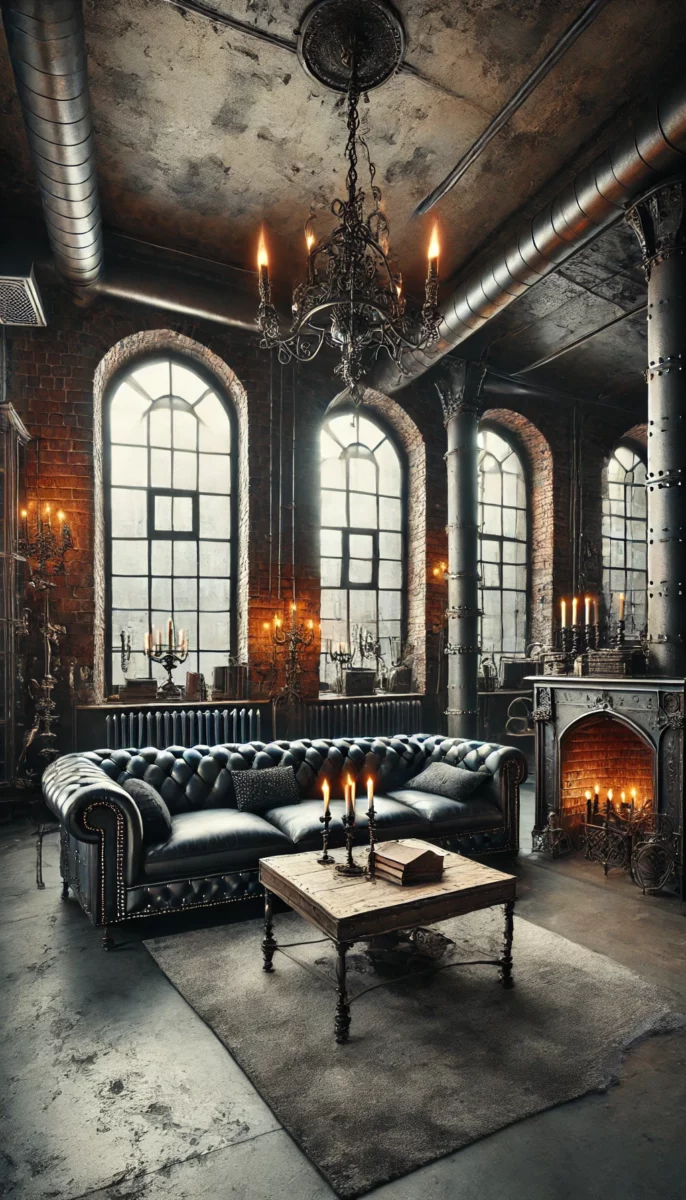
The color palette centers around charcoal grays, blacks, and oxidized metal tones, with perhaps hints of deep red or purple for dimension.
Expose structural elements whenever possible—brick walls, concrete floors, ceiling beams, and ductwork create an authentic foundation for this style.
Furniture should feature metal frames, preferably with a patina or blackened finish, combined with leather, canvas, or dark wood elements.
Lighting fixtures made from repurposed industrial objects, Edison bulbs, or metal cage pendants create appropriate illumination while enhancing the aesthetic.
Incorporate machinery parts, gears, or industrial artifacts as decorative elements that tell a story of technological decay.

Large-scale art featuring urban exploration photographs, abandoned buildings, or abstract representations of mechanical elements adds visual interest.
Create functional divisions using metal room dividers, open shelving units, or repurposed factory windows that maintain the industrial open concept while defining separate areas.
Textiles should be simple but textural—worn leather, heavy canvas, or distressed fabrics add warmth without compromising the industrial edge.
Don’t shy away from showing wear and patina—scratches, rust, and signs of age add authenticity to this style rather than detracting from it.
6. Occult Gothic: The Hidden Mysteries
For those drawn to the esoteric side of gothic aesthetics, an occult-themed living room creates space for contemplation of life’s great mysteries and celebration of ancient wisdom.
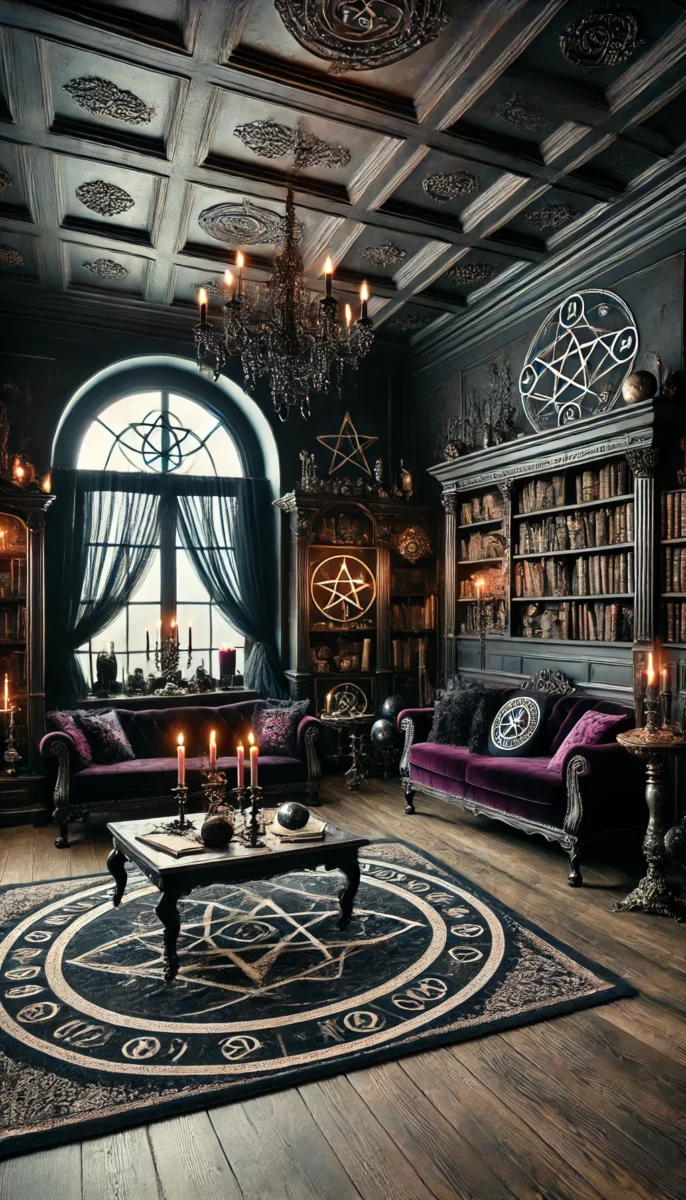
The color scheme typically features black, deep purples, midnight blues, and metallic accents in silver, gold, or copper that reflect candlelight in mysterious ways.
Furniture should be substantial and grounding—dark wood pieces with clean lines provide the perfect foundation for displaying your occult collections.
Create a focal point with a cabinet of curiosities containing crystals, tarot cards, unusual specimens, or other objects that hold personal magical significance.
Wall decorations might include framed alchemical diagrams, astrological charts, or symbolic art representing various magical traditions that resonate with you.
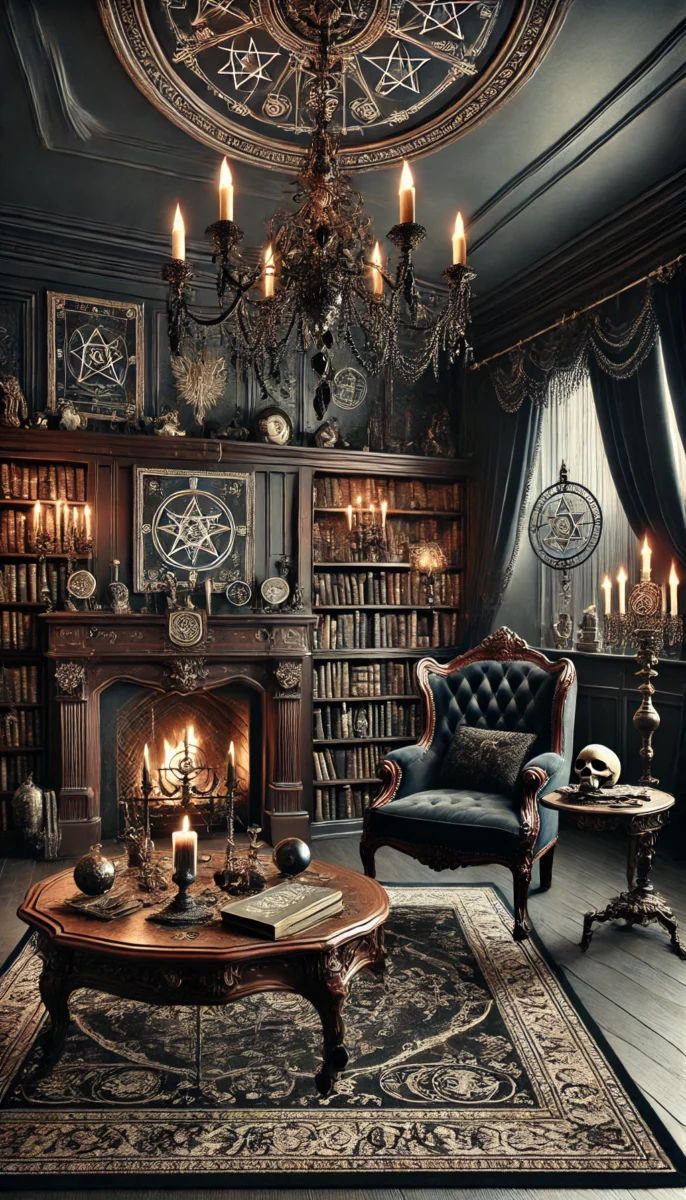
Lighting plays a crucial role—consider salt lamps, candles in strategic arrangements, or fixtures that cast intriguing shadows that seem to shift and move.
Books become both functional and decorative elements—display your collection of occult literature, grimoires, or beautifully bound volumes on open shelving.
Incorporate mirrors strategically, perhaps positioned to reflect candlelight or create the illusion of portals to other realms.
Textiles might feature cosmic prints, symbolic patterns, or rich textures that invite touch and create comfort during long nights of contemplation.
Remember that authentic occult spaces are deeply personal—each object should have meaning rather than being chosen merely for aesthetic appeal.
7. Gothic Maximalism: Gloriously Too Much
When restraint simply isn’t your style, gothic maximalism embraces the “more is more” philosophy while maintaining a cohesive dark aesthetic that’s dramatic, personal, and utterly captivating.

The color palette remains anchored in blacks and deep tones, but can incorporate unexpected pops of jewel tones, metallics, or even neon accents that stand out against the dark background.
Layer patterns fearlessly—damask, skulls, florals, and stripes can coexist when unified by a consistent color story and thoughtful placement.
Fill your walls completely with an eclectic gallery featuring artwork, mirrors, taxidermy, masks, and three-dimensional objects that create a sense of organized chaos.
Furniture should be dramatic and varied—mix Victorian pieces with contemporary items, ornate with minimal, high with low to create visual interest and conversation starters.
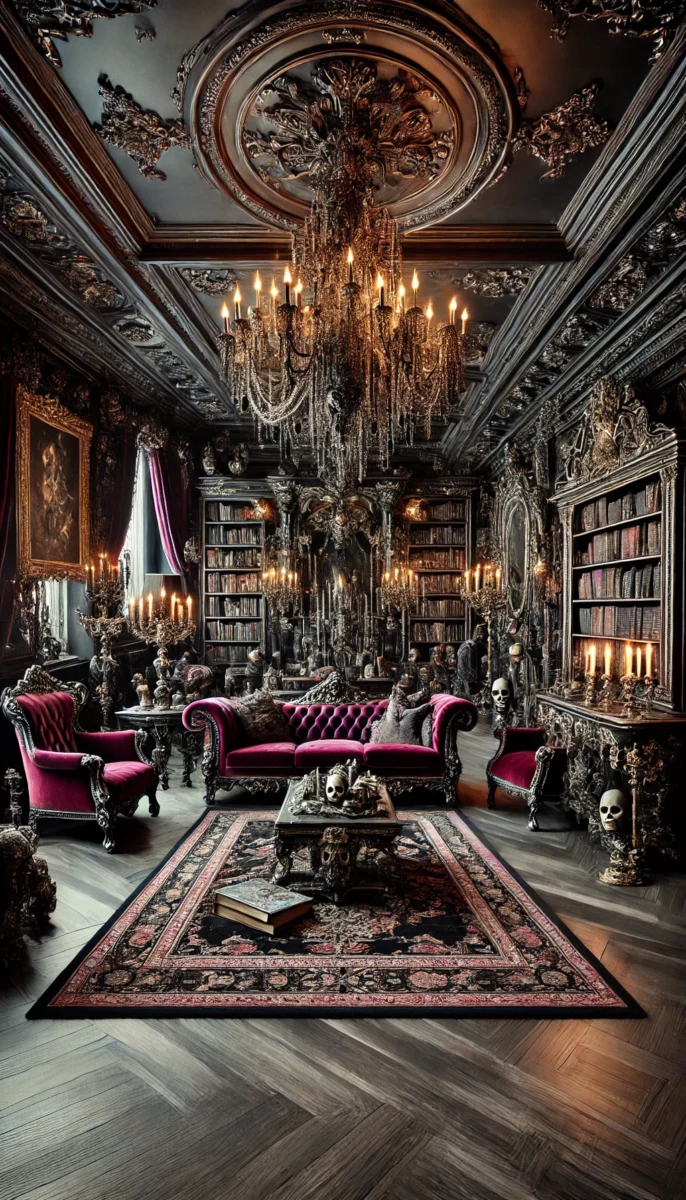
Lighting options should be abundant—chandeliers, table lamps, floor lamps, candles, and string lights create layers of illumination at different heights.
Textiles should be abundant and varied—layer multiple rugs, pile cushions of different patterns but complementary colors, and drape furniture with throws that add texture.
The ceiling becomes another canvas—consider painting it black, adding a mural, or hanging items like dried flowers, paper bats, or fabric that creates a canopy effect.
Remember that successful maximalism requires editing and organization—every item should have intention, even when the overall effect appears delightfully chaotic.
8. Elegant Monochrome Gothic: The Power of Black and White
For those who appreciate restraint without sacrificing gothic impact, a monochromatic approach creates sophisticated spaces that feel both timeless and contemporary.
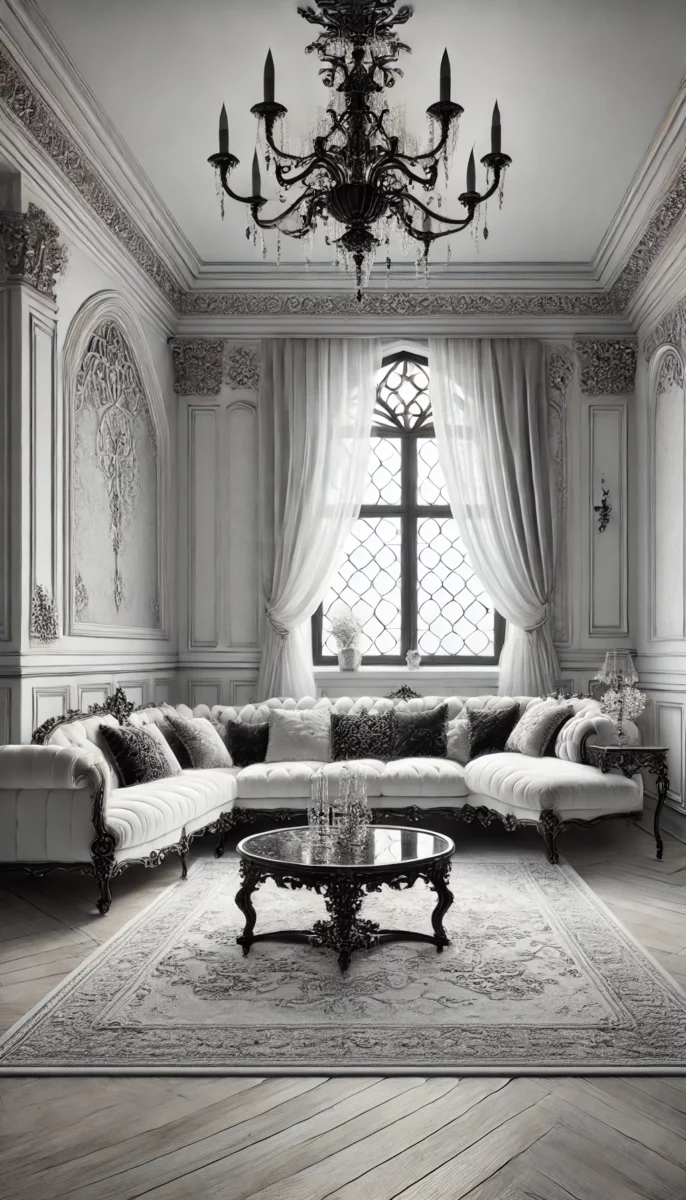
Limit your palette strictly to blacks, whites, and grays, with perhaps the smallest hints of silver or gold as metallic accents.
Texture becomes essential in maintaining visual interest—contrast glossy black surfaces with matte finishes, rough stone with smooth leather, and fluffy textiles with sleek metals.
Furniture should feature clean lines and simplified silhouettes that let the monochromatic treatment take center stage.
Architectural details like crown molding, wainscoting, or ceiling medallions painted in contrasting black or white create dramatic definition.
Lighting fixtures should be sculptural statements—perhaps a black chandelier against a white ceiling or sleek wall sconces that cast interesting shadows.
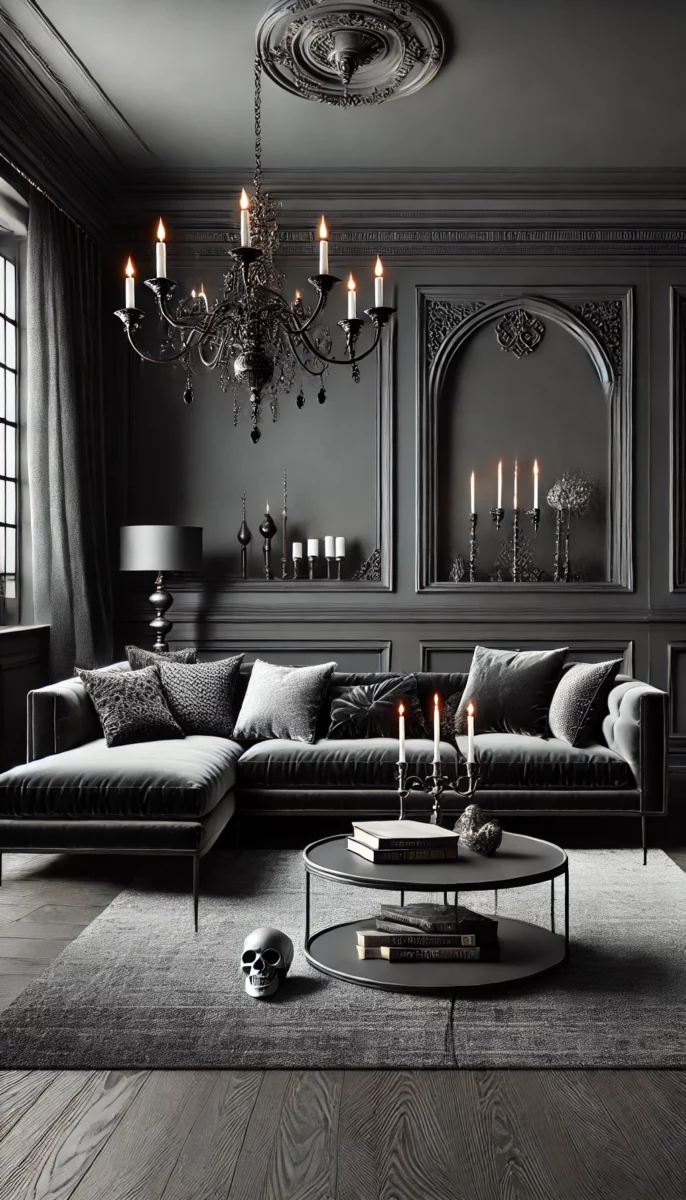
Incorporate pattern through texture rather than color—consider tone-on-tone damask wallpaper, striped upholstery, or geometric rugs that add depth without breaking the monochrome commitment.
Artwork should maintain the black and white theme—photography, charcoal drawings, or graphic prints create focal points without disrupting the color discipline.
Plants add natural elements while respecting the palette—white orchids, black mondas, or silvery air plants bring life without introducing unwanted color.
The beauty of this approach lies in its intentional limitations—commit fully to the monochrome concept for maximum sophisticated gothic impact.
✨Click to Get My 101 FREE Designer Room Ideas
9. Medieval Gothic: Castle Dreams
Channel the original gothic era by creating a living space that draws inspiration from medieval castles, monasteries, and the architecture that first defined “gothic” as a style.
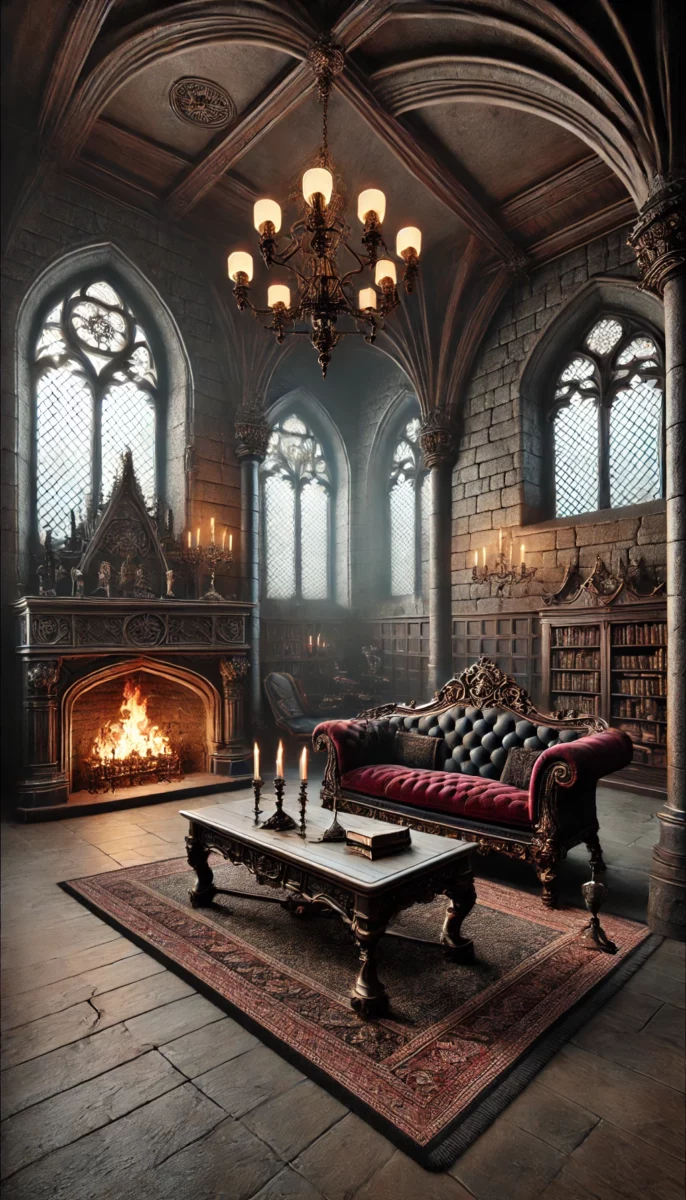
The color palette draws from natural materials—stone grays, wood browns, black wrought iron, and perhaps deep reds or blues as accents.
Furniture should be substantial and rustic—heavy wooden tables, throne-like chairs, and storage pieces that mimic treasure chests or medieval coffers.
Create architectural interest with arched doorways, faux stone veneer, or wall treatments that mimic castle interiors using textured plaster or stone-look panels.
Lighting can be transformed with wrought iron chandeliers, wall-mounted torch-style sconces, or lanterns that create the flickering effect of flame.
Hang tapestries, shields, or reproduction medieval weapons as wall decorations that add authenticity and texture to your castle-inspired space.
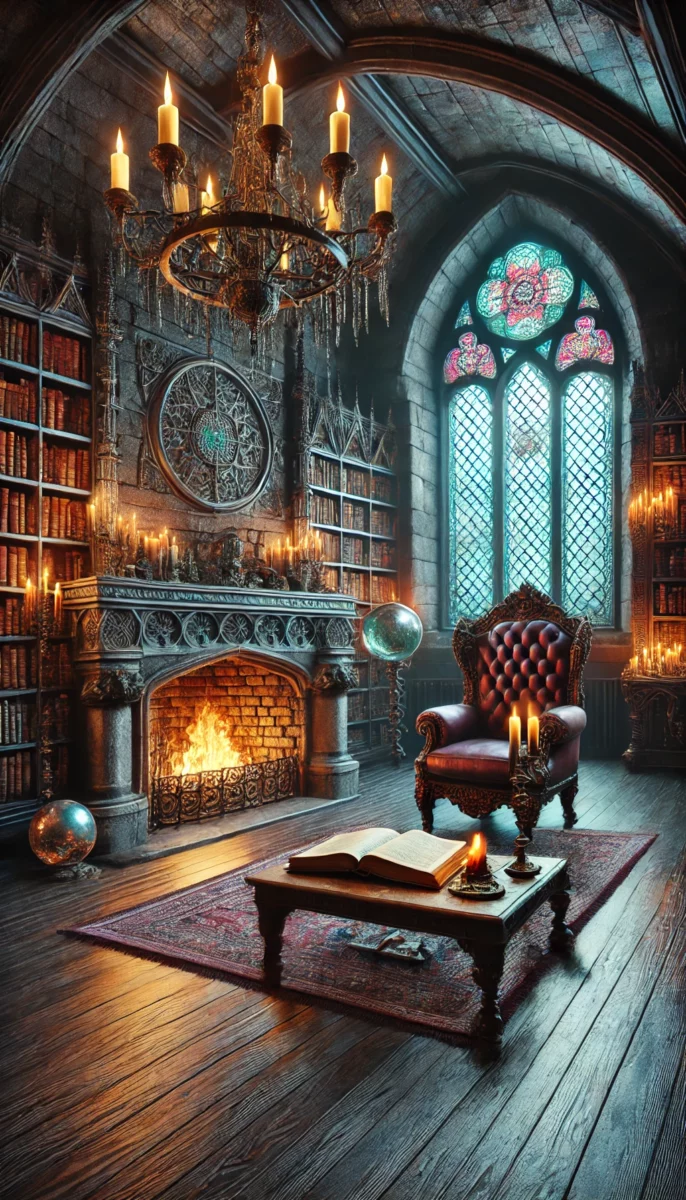
Incorporate religious architectural elements like gothic arches, quatrefoil patterns, or stained glass window treatments that filter light in colored patterns.
Textiles should feel both rustic and luxurious—faux fur throws, heavy linen, and tapestry-style fabrics add warmth and period authenticity.
Create a modern hearth area that mimics a great hall fireplace—even if you don’t have a working fireplace, you can create a focal point with candles, stone surrounds, or electric options.
Consider incorporating actual salvaged architectural elements from old churches or buildings if you can source them ethically—these instantly add medieval character.
10. Steampunk Gothic: Victorian Futurism
Blend the darkness of gothic aesthetics with the brass, gears, and reimagined Victorian technology of steampunk for a living room that feels like a mad scientist’s parlor.
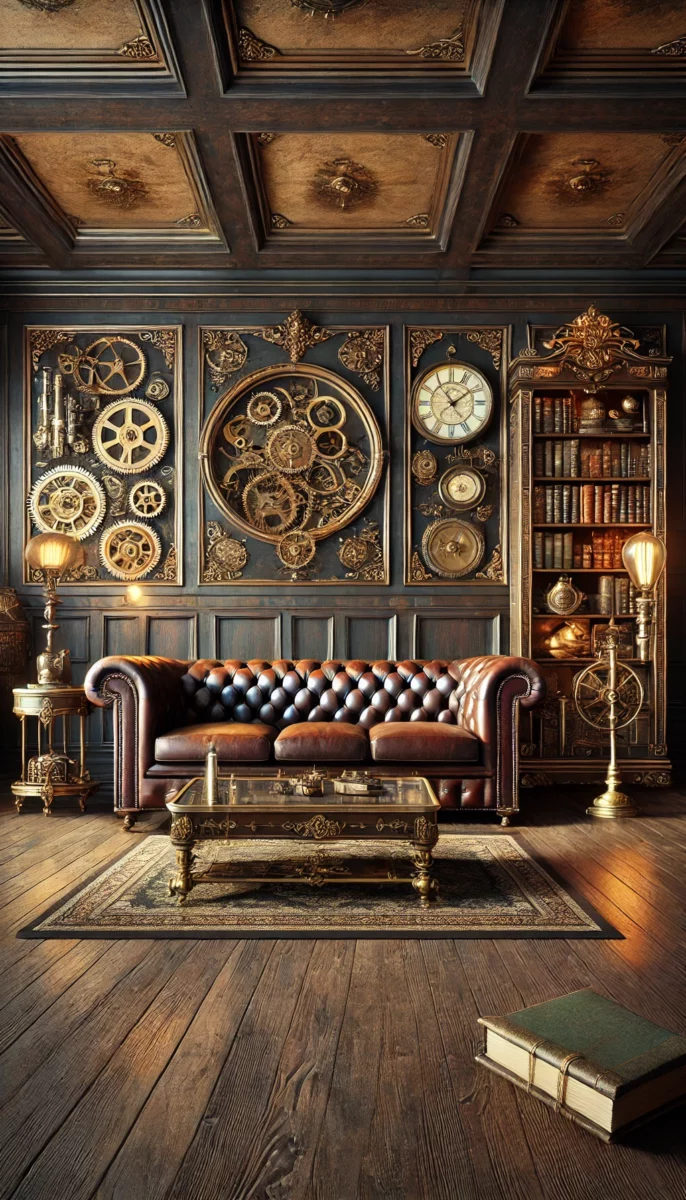
The color palette centers around rich browns, blacks, and metallic tones—particularly brass, copper, and bronze that will develop beautiful patinas over time.
Furniture should feature leather, exposed wood, and metal details—look for pieces with mechanical elements, visible gears, or industrial touches.
Lighting becomes a major feature with modified fixtures featuring Edison bulbs, exposed filaments, brass details, and mechanical elements that look functional.
Create displays of retrofuturistic gadgets, modified antiques, or steampunk sculptures that imagine Victorian technology evolved in fascinating directions.

Wall treatments might include gear-patterned wallpaper, maps, technical drawings, or copper panels that develop natural verdigris over time.
Incorporate actual vintage scientific instruments, apothecary bottles, or technology pieces as decorative elements that tell a story of alternative history.
Consider installing pipes, gauges, or switches as wall decorations—they don’t need to be functional, just visually interesting and authentic-looking.
Textiles should include leather, canvas, and other durable materials that would be at home in an airship captain’s quarters or an inventor’s workshop.
Don’t forget to include books—scientific tomes, leather-bound journals, and collections of speculative fiction create both atmosphere and entertainment.
11. Gothic Bohemian: Free-Spirited Darkness
For the nonconformist who embraces both darkness and eclectic self-expression, gothic bohemian style creates spaces that feel personal, layered, and comfortably mysterious.
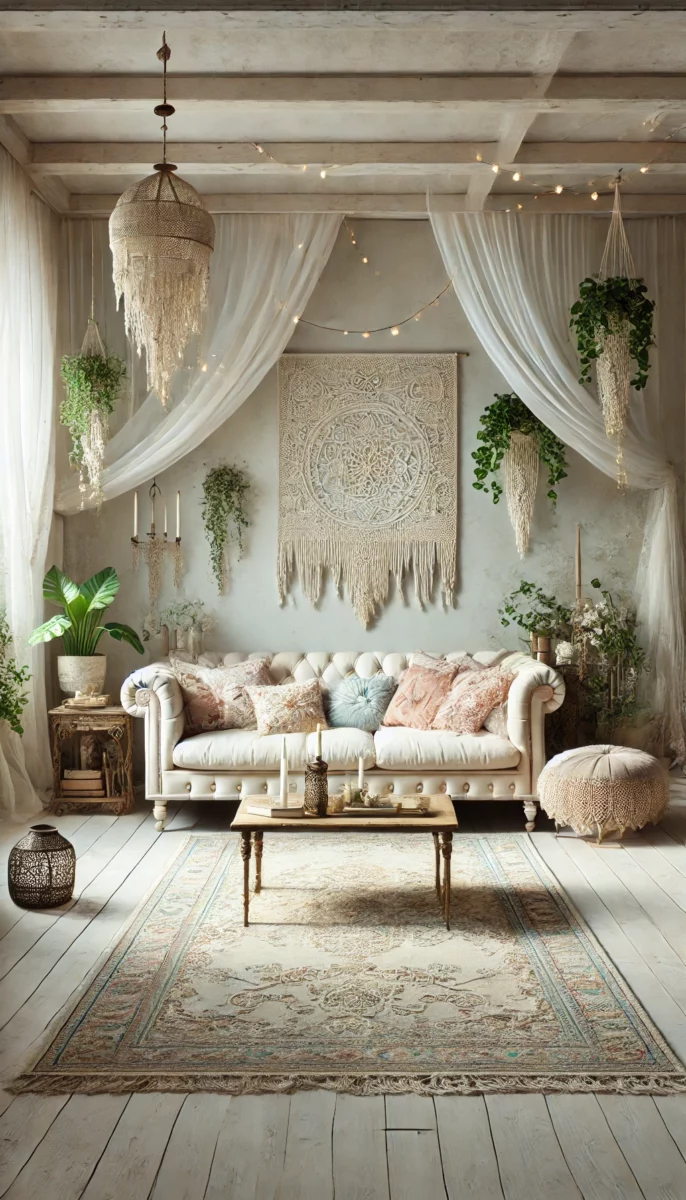
The color palette expands beyond traditional gothic darkness to include deep jewel tones like emerald, sapphire, amethyst, and ruby alongside the requisite black base notes.
Furniture should feel collected rather than purchased as a set—mix vintage pieces, global-inspired items, and comfort-focused seating with gothic elements.
Textiles become a major feature with layered rugs, abundant cushions in varied textures, and draping fabrics that might hang from the ceiling or walls to create intimate spaces.
Incorporate global influences through Moroccan lanterns, Indian textiles, or Mexican folk art that adds cultural depth while maintaining a dark aesthetic.
Plants become essential elements—hanging vines, unusual succulents, and dramatic statement plants add life and bohemian authenticity.

Lighting should be abundant but soft—paper lanterns, string lights, and multiple small lamps create pools of illumination rather than harsh overhead lighting.
Display collections that tell your personal story—crystals, unusual found objects, vintage clothing as decor, or handcrafted items that showcase your creative spirit.
The walls might feature tapestries, macramé in black or deep colors, masks from global traditions, or salon-style art arrangements that grow organically over time.
Music and instruments can become decor elements—display guitars, vintage record players, or unusual instruments from around the world as functional art pieces.
12. Pastel Goth: Softly Sinister
Challenging traditional gothic color schemes, pastel goth creates spaces that merge kawaii cuteness with macabre elements for a freshly subversive take on dark decor.
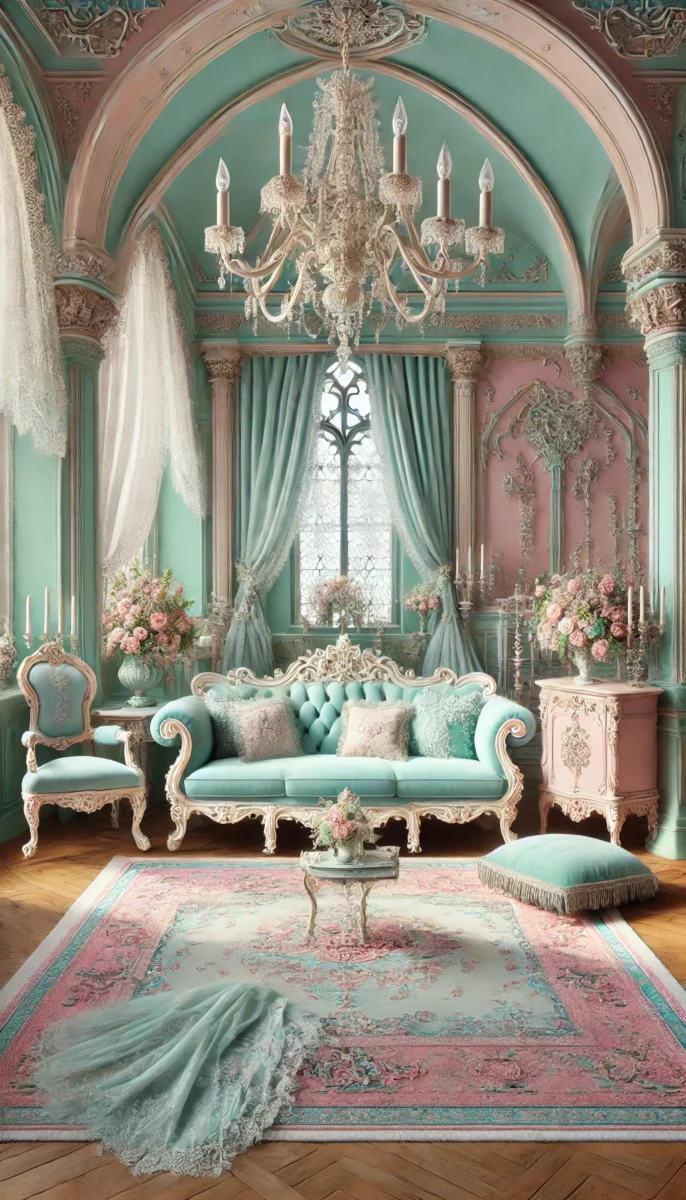
The color palette features soft lavenders, mint greens, baby blues, and pale pinks alongside black accents that ground the sweetness in darkness.
Furniture should maintain gothic silhouettes but might be upholstered in pastel velvet or feature unexpected details like gold hardware or painted accents.
Create contrast by pairing traditionally cute items with darker elements—perhaps a pastel sofa decorated with skull-shaped pillows or coffin shelves painted in mint green.
Lighting can include chandeliers spray-painted in soft colors, neon signs with gothic phrases, or fairy lights arranged in spider web patterns.
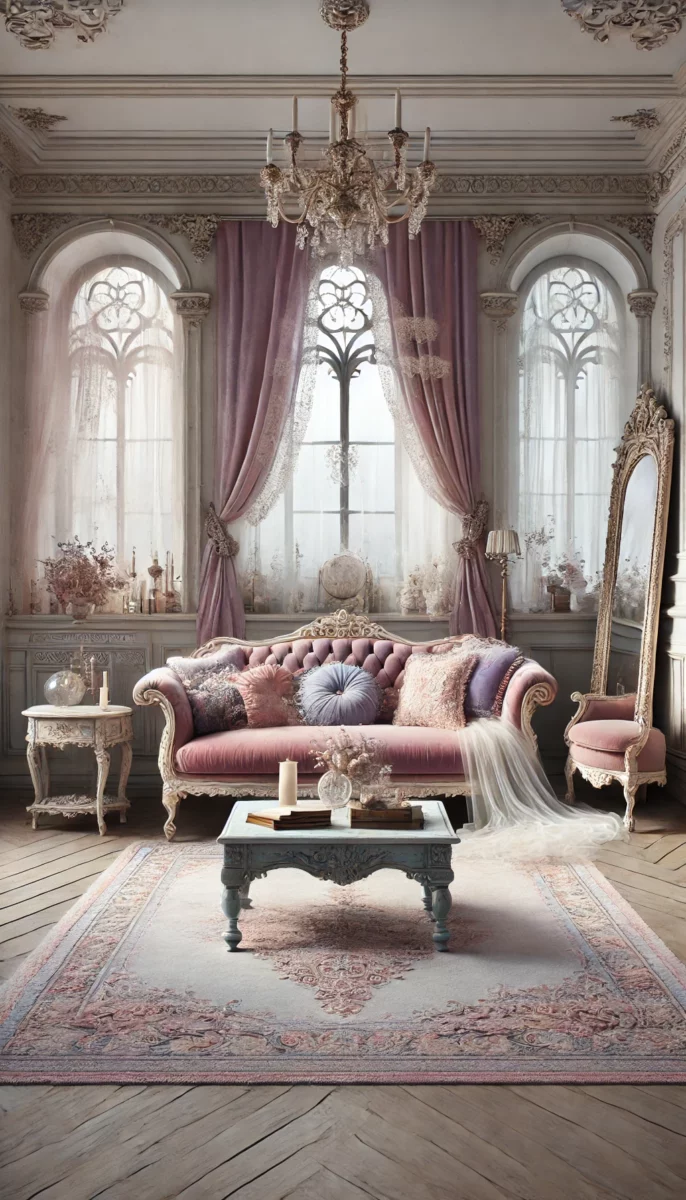
Wall treatments might include ombre effects from black to pastel shades, cute-but-creepy wallpaper patterns, or salon walls mixing kawaii art with gothic imagery.
Incorporate Japanese or Korean influences through decorative elements, character goods with a gothic twist, or manga-inspired artwork that bridges cute and creepy.
Textiles should be touchably soft—fluffy rugs, plush throws, and cushions in various pastel shades create comfort while maintaining the aesthetic.
Display collections of toys or figurines that exemplify the pastel goth aesthetic—think gothic Hello Kitty variants, pastel-colored skulls, or cute bats and spiders.
Don’t forget the power of scent in creating atmosphere—sweet fragrances with darker notes like black cherry, vanilla and patchouli, or cotton candy and incense support the juxtaposition of cute and creepy.
✨Click to Get My 101 FREE Designer Room Ideas
13. Digital Gothic: The Cyber Underworld
Furniture should feature sleek, almost liquid-looking pieces with high-gloss finishes alongside matte black elements that absorb light rather than reflect it.

Incorporate LED lighting strategically—hidden strips behind furniture, color-changing bulbs, or reactive lighting systems that pulse with your music create an immersive atmosphere.
Display screens become both functional and decorative elements—digital art frames cycling through gothic imagery, visualizers that respond to sound, or vintage monitors repurposed as light sources.
Consider transparent or translucent furniture elements with colored lighting that creates an otherworldly glow reminiscent of cyberpunk fiction.
Cable management becomes an art form—either hide technology completely for a clean look or display it intentionally as decorative elements with custom-colored cabling.
Wall treatments might include projection mapping for changing environments, sound-absorbing panels in geometric patterns, or reflective surfaces that interact with your lighting setup.
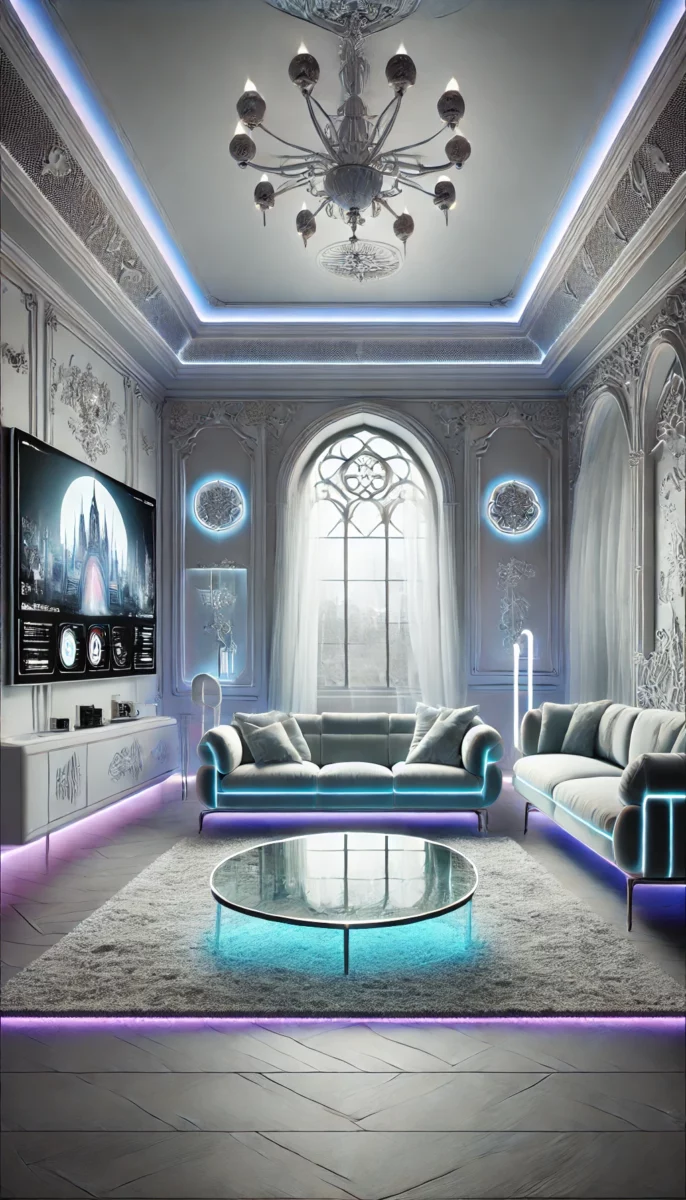
Textiles should include technical fabrics—perhaps those with reflective properties, temperature-responsive elements, or unusual textures that feel futuristic to the touch.
Create a command center feeling with a thoughtfully arranged desk setup featuring mechanical keyboards with custom keycaps, unusual input devices, and cable organization that looks intentional rather than cluttered.
Consider using small robotics, 3D printed gothic sculptures, or interactive elements that respond to presence or touch for a truly immersive digital gothic experience.
Remember that this style celebrates the intersection of technology and darkness—your devices should feel like natural extensions of your aesthetic rather than necessary intrusions.

